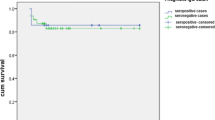Abstract
Purpose
Previous epidemiologic studies have observed positive associations between Trichomonas vaginalis (Tv) serostatus and both prostate cancer (PCa) risk and mortality. However, only a few small older studies have examined Tv antibody persistence over time, all of which were composed mainly of female patients. Therefore, we examined Tv antibody persistence over time, as well as intra-individual variability, among middle- to older-aged men in the Southern Community Cohort Study (SCCS).
Methods
We tested baseline and repeat plasma specimens (collected 1–3 years later) from 248 male participants for Tv antibodies. We used the same enzyme-linked immunosorbent assay as in previous studies of Tv serostatus and PCa.
Results
At baseline, 46 (18.5 %) participants were seropositive for Tv infection. Seventy-six percent of these men were still seropositive 1–3 years later. A similar proportion of men “seroconverted” (4.0 %) as “seroreverted” (4.4 %), all of whom had absorbance values near the cutoff point for seropositivity. Overall, substantial agreement was observed between baseline and repeat serostatus (κ = 0.72, 95 % confidence interval 0.60–0.83).
Conclusion
Tv seropositivity was largely persistent between plasma specimens collected 1–3 years apart from middle- to older-aged men. These high levels of persistence are similar to those observed for other sexually transmitted infections frequently investigated in relation to PCa.

Similar content being viewed by others
References
Holmes KK et al (eds) (2008) Sexually transmitted diseases, 4th edn. McGraw-Hill, New York
Sutcliffe S (2010) Sexually transmitted infections and risk of prostate cancer: review of historical and emerging hypotheses. Fut Oncol 6(8):1289–1311
Sutcliffe S et al (2012) Trichomonosis, a common curable STI, and prostate carcinogenesis—a proposed molecular mechanism. PLoS Pathog 8(8):e1002801
Twu O et al (2014) Trichomonas vaginalis homolog of macrophage migration inhibitory factor induces prostate cell growth, invasiveness, and inflammatory responses. Proc Natl Acad Sci USA 111(22):8179–8184
Sutcliffe S et al (2006) Plasma antibodies against Trichomonas vaginalis and subsequent risk of prostate cancer. Cancer Epidemiol Biomark Prev 15(5):939–945
Stark JR et al (2009) Prospective study of Trichomonas vaginalis infection and prostate cancer incidence and mortality: physicians’ health study. J Natl Cancer Inst 101(20):1406–1411
Howlader N et al (2012) SEER cancer statistics review, 1975–2009 (Vintage 2009 Populations). National Cancer Institute. Bethesda, MD, http://seer.cancer.gov/csr/1975_2009_pops09/, based on November 2011 SEER data submission, posted to the SEER web site, April 2012
Sutcliffe S et al (2009) Trichomonosis and subsequent risk of prostate cancer in the Prostate Cancer Prevention Trial. Int J Cancer 124(9):2082–2087
Cogne M, Brasseur P, Ballet JJ (1985) Detection and characterization of serum antitrichomonal antibodies in urogenital trichomoniasis. J Clin Microbiol 21(4):588–592
Sibau L et al (1987) Enzyme-linked immunosorbent assay for the diagnosis of trichomoniasis in women. Sex Transm Dis 14(4):216–220
Narvanen A et al (1997) Detection of antibodies to Chlamydia trachomatis with peptide-based species-specific enzyme immunoassay. Infect Dis Obstet Gynecol 5(5):349–354
Dunne EF et al (2006) Prevalence of HPV infection among men: a systematic review of the literature. J Infect Dis 194(8):1044–1057
Fleming DT et al (1997) Herpes simplex virus type 2 in the United States, 1976 to 1994. N Engl J Med 337(16):1105–1111
van Aar F et al (2014) Chlamydia trachomatis IgG seroprevalence in the general population of the Netherlands in 1996 and in 2007: differential changes by gender and age. Sex Transm Infect 90(5):434–440
Signorello LB et al (2005) Southern community cohort study: establishing a cohort to investigate health disparities. J Natl Med Assoc 97(7):972–979
Neace CJ, Alderete JF (2013) Epitopes of the highly immunogenic Trichomonas vaginalis alpha-actinin are serodiagnostic targets for both women and men. J Clin Microbiol 51(8):2483–2490
Alderete JF (1984) Enzyme linked immunosorbent assay for detecting antibody to Trichomonas vaginalis: use of whole cells and aqueous extract as antigen. Br J Vener Dis 60(3):164–170
Alderete JF, Neace CJ (2013) Identification, characterization, and synthesis of peptide epitopes and a recombinant six-epitope protein for Trichomonas vaginalis serodiagnosis. ImmunoTargets Therapy 2:91–103
Horner PJ et al (2013) Effect of time since exposure to Chlamydia trachomatis on chlamydia antibody detection in women: a cross-sectional study. Sex Transm Infect 89(5):398–403
Wang SS et al (2004) Determinants of human papillomavirus 16 serological conversion and persistence in a population-based cohort of 10,000 women in Costa Rica. Br J Cancer 91(7):1269–1274
Clad A et al (2000) Detection of seroconversion and persistence of Chlamydia trachomatis antibodies in five different serological tests. Eur J Clin Microbiol Infect Dis 19(12):932–937
Huang WY et al (2008) Sexually transmissible infections and prostate cancer risk. Cancer Epidemiol Biomark Prev 17(9):2374–2381
Sutton M et al (2007) The prevalence of Trichomonas vaginalis infection among reproductive-age women in the United States, 2001-2004. Clin Infect Dis 45(10):1319–1326
Mitchell HD et al (2014) Distribution and risk factors of Trichomonas vaginalis infection in England: an epidemiological study using electronic health records from sexually transmitted infection clinics, 2009–2011. Epidemiol Infect 142(8):1678–1687
Waner JL, Weller TH, Kevy SV (1973) Patterns of cytomegaloviral complement-fixing antibody activity: a longitudinal study of blood donors. J Infect Dis 127(5):538–543
Acknowledgments
We thank Ratna Pakpahan for assistance with Fig. 1.
Financial support
This study was funded by Grant R01 CA092447 from the National Cancer Institute. S.S. was funded by the Barnes-Jewish Hospital Foundation.
Author information
Authors and Affiliations
Corresponding author
Ethics declarations
Potential conflicts of interest
None.
Rights and permissions
About this article
Cite this article
Sutcliffe, S., Alderete, J.F., Neace, C. et al. Persistence of Trichomonas vaginalis serostatus in men over time. Cancer Causes Control 26, 1461–1466 (2015). https://doi.org/10.1007/s10552-015-0642-0
Received:
Accepted:
Published:
Issue Date:
DOI: https://doi.org/10.1007/s10552-015-0642-0



